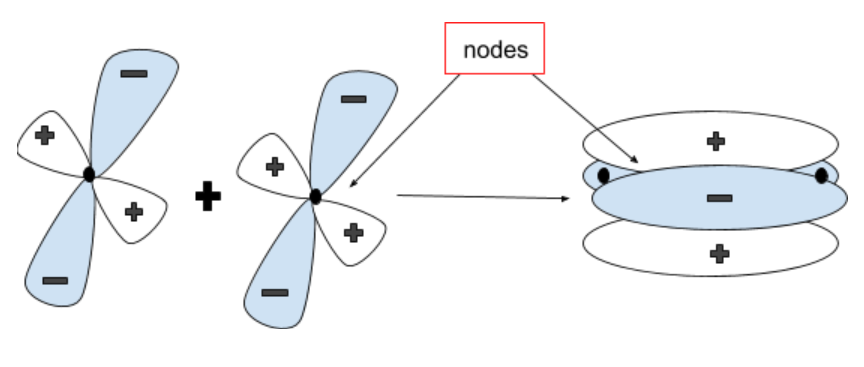
How many nodal planes are present in
Answer
509.7k+ views
Hint: Nodal planes can be defined as the region around the nucleus in an atomic orbital where the chances of electrons being present is negligible. In Delta bonding of a molecular orbital, all four lobes of D orbital of an atom overlap the lobes of another atom. We can use this concept to understand the answer to this question.
Complete step-by-step answer:
Atomic orbitals are the ones where an electron is attached to a single nucleus whereas a molecular orbital is when an electron can be found in the presence of two or more nuclei.
A molecule is an assembly of atoms and by extension, a molecular orbital is a bond between two or more atomic orbitals. Molecular orbitals serve the purpose of holding multiple atoms together while an atomic orbital holds the electrons and the neutrons together.
There are three types of bonding between molecular orbitals – sigma
Sigma bond is a single covalent bond which is formed by head to head overlap of two atomic orbitals. The nuclei in both the atomic orbitals is joined along the bonding axis.
Pi bond is formed by side to side overlap of two atomic orbitals.
It allows the formation of a quadruple bond.

Hence, a
Note – Sigma, pi and delta bonds depict how many Nodal planes are there in the bond. A Sigma bond does not have any nodal plane since it is joined along a bonding axis. Pi bonds have one and delta bonds have two nodal planes. One can tell what bond is being formed by judging how the orbitals overlap each other.
Complete step-by-step answer:
Atomic orbitals are the ones where an electron is attached to a single nucleus whereas a molecular orbital is when an electron can be found in the presence of two or more nuclei.
A molecule is an assembly of atoms and by extension, a molecular orbital is a bond between two or more atomic orbitals. Molecular orbitals serve the purpose of holding multiple atoms together while an atomic orbital holds the electrons and the neutrons together.
There are three types of bonding between molecular orbitals – sigma
Sigma bond is a single covalent bond which is formed by head to head overlap of two atomic orbitals. The nuclei in both the atomic orbitals is joined along the bonding axis.
Pi bond is formed by side to side overlap of two atomic orbitals.
It allows the formation of a quadruple bond.

Hence, a
Note – Sigma, pi and delta bonds depict how many Nodal planes are there in the bond. A Sigma bond does not have any nodal plane since it is joined along a bonding axis. Pi bonds have one and delta bonds have two nodal planes. One can tell what bond is being formed by judging how the orbitals overlap each other.
Latest Vedantu courses for you
Grade 6 | CBSE | SCHOOL | English
Vedantu 6 Pro Course (2025-26)
School Full course for CBSE students
₹45,300 per year
EMI starts from ₹3,775 per month
Recently Updated Pages
Master Class 9 General Knowledge: Engaging Questions & Answers for Success

Master Class 9 English: Engaging Questions & Answers for Success

Master Class 9 Science: Engaging Questions & Answers for Success

Master Class 9 Social Science: Engaging Questions & Answers for Success

Master Class 9 Maths: Engaging Questions & Answers for Success

Class 9 Question and Answer - Your Ultimate Solutions Guide

Trending doubts
Give 10 examples of unisexual and bisexual flowers

Draw a labelled sketch of the human eye class 12 physics CBSE

Differentiate between homogeneous and heterogeneous class 12 chemistry CBSE

Differentiate between insitu conservation and exsitu class 12 biology CBSE

What are the major means of transport Explain each class 12 social science CBSE

Why is the cell called the structural and functional class 12 biology CBSE




